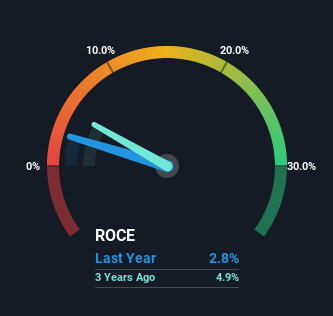- Singapore
- /
- Specialty Stores
- /
- SGX:5SO
Duty Free International (SGX:5SO) May Have Issues Allocating Its Capital
If we're looking to avoid a business that is in decline, what are the trends that can warn us ahead of time? More often than not, we'll see a declining return on capital employed (ROCE) and a declining amount of capital employed. Trends like this ultimately mean the business is reducing its investments and also earning less on what it has invested. So after glancing at the trends within Duty Free International (SGX:5SO), we weren't too hopeful.
Return On Capital Employed (ROCE): What Is It?
For those that aren't sure what ROCE is, it measures the amount of pre-tax profits a company can generate from the capital employed in its business. To calculate this metric for Duty Free International, this is the formula:
Return on Capital Employed = Earnings Before Interest and Tax (EBIT) ÷ (Total Assets - Current Liabilities)
0.028 = RM13m ÷ (RM478m - RM27m) (Based on the trailing twelve months to February 2023).
Thus, Duty Free International has an ROCE of 2.8%. Ultimately, that's a low return and it under-performs the Specialty Retail industry average of 8.6%.
See our latest analysis for Duty Free International

Historical performance is a great place to start when researching a stock so above you can see the gauge for Duty Free International's ROCE against it's prior returns. If you're interested in investigating Duty Free International's past further, check out this free graph of past earnings, revenue and cash flow.
How Are Returns Trending?
The trend of ROCE at Duty Free International is showing some signs of weakness. To be more specific, today's ROCE was 12% five years ago but has since fallen to 2.8%. In addition to that, Duty Free International is now employing 25% less capital than it was five years ago. The combination of lower ROCE and less capital employed can indicate that a business is likely to be facing some competitive headwinds or seeing an erosion to its moat. If these underlying trends continue, we wouldn't be too optimistic going forward.
On a side note, Duty Free International has done well to pay down its current liabilities to 5.7% of total assets. That could partly explain why the ROCE has dropped. What's more, this can reduce some aspects of risk to the business because now the company's suppliers or short-term creditors are funding less of its operations. Some would claim this reduces the business' efficiency at generating ROCE since it is now funding more of the operations with its own money.
What We Can Learn From Duty Free International's ROCE
In summary, it's unfortunate that Duty Free International is shrinking its capital base and also generating lower returns. Despite the concerning underlying trends, the stock has actually gained 9.6% over the last five years, so it might be that the investors are expecting the trends to reverse. Either way, we aren't huge fans of the current trends and so with that we think you might find better investments elsewhere.
On a separate note, we've found 1 warning sign for Duty Free International you'll probably want to know about.
While Duty Free International may not currently earn the highest returns, we've compiled a list of companies that currently earn more than 25% return on equity. Check out this free list here.
New: Manage All Your Stock Portfolios in One Place
We've created the ultimate portfolio companion for stock investors, and it's free.
• Connect an unlimited number of Portfolios and see your total in one currency
• Be alerted to new Warning Signs or Risks via email or mobile
• Track the Fair Value of your stocks
Have feedback on this article? Concerned about the content? Get in touch with us directly. Alternatively, email editorial-team (at) simplywallst.com.
This article by Simply Wall St is general in nature. We provide commentary based on historical data and analyst forecasts only using an unbiased methodology and our articles are not intended to be financial advice. It does not constitute a recommendation to buy or sell any stock, and does not take account of your objectives, or your financial situation. We aim to bring you long-term focused analysis driven by fundamental data. Note that our analysis may not factor in the latest price-sensitive company announcements or qualitative material. Simply Wall St has no position in any stocks mentioned.
About SGX:5SO
Duty Free International
An investment holding company, operates as a duty-free retailer under the Zon brand in Malaysia.
Flawless balance sheet and good value.
Market Insights
Community Narratives




